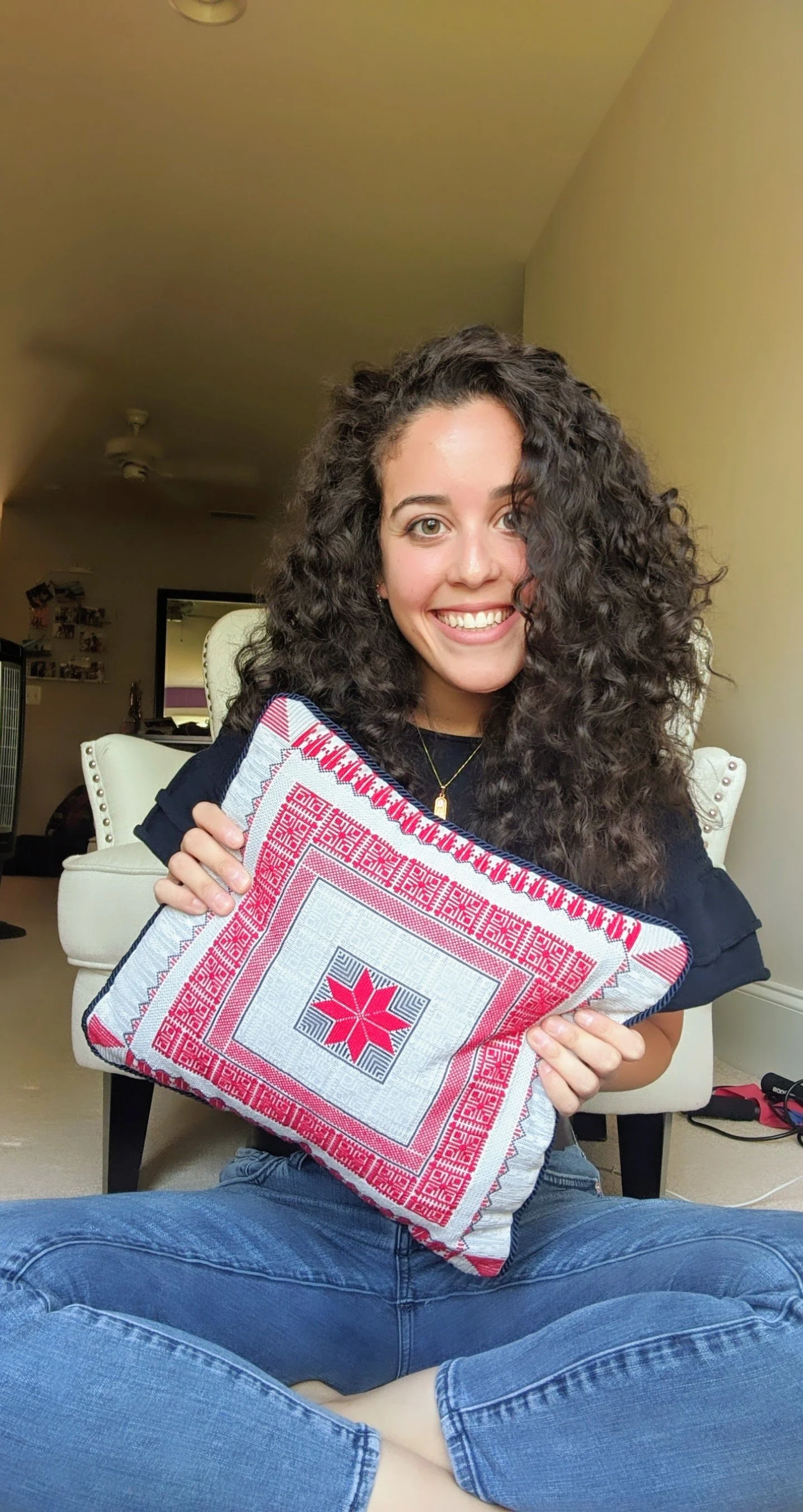Lina’s Thobe
Embroidering identity with traditional Palestinian cross-stitch
On paper, Lina Barkawi and I don’t have much in common. We live at opposite ends of the Atlantic and had very different upbringings. Yet, when we sat down to chat in June 2025, our shared experience of creativity, crafting and making something from our imagination come to life connected us in a very special way. Learning about Lina’s ancestral practice of Tatreez was enlightening for me.
What is Tatreez and a Thobe?
With a Panamanian mother and Palestinian father, Lina was born and raised in the US, spent eight years in the Middle East, and now lives in New York City. Growing up, crafting was a big part of her life and her mum taught her cross-stitch at a young age: “At around 12 years’ old, I would make gifts for my friends where I’d cross-stich their names and frame it, for example.”
In 2019, she took a class for traditional Palestinian cross-stitch: Tatreez. It was a new – yet familiar – world for Lina. Not only did she realise that Tatreez is cross-stitch, a technique she was familiar with for many years, she also realised that she was surrounded by it in her childhood home. “Suddenly, I saw it everywhere at home: on pillow cases and wall hangings. That’s when I became obsessed.”
Tatreez consists of a specific set of meaningful motifs and symbols, which women used to share aspects of their life. “When I learned about this aspect in the first class, I immediately felt a strong attraction to Tatreez”, says Lina.
After her first Tatreez class, Lina did project after project. It culminated in making her first own thobe: a traditional Palestinian dress usually with long sleeves, a V- or square neck and six panels that can be used for Tatreez. Struggling to find any information about how to make thobes online, Lina taught herself how to sew garments and make fit adjustments to a sewing pattern. She started her Instagram account Lina’s Thobe as a way to document this monumental make.
Lina Barkawi with her first sewing project: She stitched the large pattern, bought a sewing machine, and scoured YouTube for how to sew up a pillow.
Tirazain is an online library of Tatreez symbols and motifs. It hosts a stunning wealth of stitch patterns, which can be filtered by project duration, colour count, origin and/or theme. For example, there are two motifs to represent ‘Watermelon’. The Basil Design from Gaza features three colours and slightly under 3000 stitches, while the Horse requires over 12,000 stitches.
History of Tatreez
Tatreez dates back hundreds of years. Historically, women would stitch on dresses, which were made to last and be passed down generations: “In historic Palestine, women embroidered what they saw around them. So, we have a lot of land-based motifs and symbols of historic architecture. They also embroidered aspects of themselves or their identity into the clothes and used different colours to showcase martial status, for example.”
After 1948, when over 700,000 Palestinians were uprooted and forced to flee, they lost their homes, livelihoods and communities. Tatreez became a source of income, which is when smaller items, like table runners, pillow cases and wall hangings started becoming increasingly present.
Lina’s a watermelon design pattern from October 2023: “A symbol of [artistic] resistance of Palestinians against their oppressors”.
During the 1980s, a lot of new and politically motivated Tatreez motifs came up, such as the watermelon symbol. It was a way for women to participate in the uprising against Israel’s oppression, which, for example, forbade the use of the Palestinian flag and its colours.
Honour the individual while supporting the collective
During the first ever Tatreez Retreat, women from all over the United States came together in October 2023 for a long weekend of grieving, Tatreez, and connection.
Nowadays, Lina teaches Tatreez and the art of thobe-making in online as well as offline classes. She also holds Tatreez circles with the goal to create a community and to foster learning among its members. Her business is ever evolving but the one constant is that she wants to value the art form of Tatreez: “My goal is to return to the early use of Tatreez: Honour the individual while supporting the collective identity.”
Tatreez has a special cultural meaning for those with Palestinian roots: “People like me, who are not born in the place your ancestors are from, we all have this identity crisis. Tatreez is a beautiful way to connect and learn about your own culture and maybe start conversations with family members, especially women.“
The aspect of community that can be found and created through a shared craft cannot be underestimated. Especially with the ongoing genocide, both crafting as well as community can offer a coping mechanism for feelings of hopelessness for those in the diaspora, says Lina.
And if you don’t have a cultural connection to Palestine? Tatreez is a beautiful way to show support and advocate for Palestine. As Lina puts it: “We need all the small acts.”
Stitch your own story
The value of crafting is making your ideas come to life. You can tell your own story. Tatreez takes this another step further: It is a way to stitch your identity onto a piece of fabric. The motifs and symbols tell a very specific and personal story of who you are and where you are from. Lina’s own thobe, for example, includes nods to her Panamanian heritage as much as it does to her Palestinian side.
This is what connected me to Lina immediately, I think, and what connects us as creative people more generally. Crafting is a storyteller as much as a connector. All we have to do is be open.






